Vintage Photos of Airmail Pilots and Planes
Using army pilots and a fleet of six converted airplanes, the United States Post Office Department began officially offering its Airmail Service in 1918. The first scheduled route operated between Washington, D.C., and New York, and though the service got off to a rough start with the pilot getting lost on his first flight and breaking his plane’s prop while making an unscheduled landing to find out where he was, eventually the airmail routes made their way all the way across country.
A few months after that first flight, civilian pilots took over flight operations from the Army, flying airplanes that had been converted from military use. This continued until 1926 when commercial air carriers took over the transport of airmail for the Post Office Department. Pictured below are the pilots, aircraft, and airmail fields of these exciting early days of the Airmail service.
(Photos in this collection are courtesy National Postal Museum, Curatorial Photographic Collection)
Pilot Eddie Gardner and Airmail Plane
Airmail pilot Eddie Gardner poses next to his Curtiss JN-4H “Jenny” airmail plane. Gardner was one of the first four pilots hired to fly mail for the Post Office Department. He served as an airmail pilot from 1918-1919.

Airmail Plane and Hangar at Elko, Nevada
Elko, Nevada was part of the last leg of the Post Office Department’s transcontinental route. The New York City to Omaha, Nebraska, portion of the route had been in operation since May 1920. On September 8, 1920, the rest of the route, from Omaha to San Francisco, California was opened for airmail flights. Pilots traveled from on the route from Omaha to North Platte, Nebraska; Cheyenne, Rawlins and Rock Springs, Wyoming; Salt Lake City, Utah; and Elko and Reno, Nevada before landing in San Francisco. The initial westbound trip was made at the speed of 80 miles per hour and completed without a forced landing.

Loading Airmail Plane for Pathfinding Transcontinental Flight
General Superintendent of the Airmail Service, L.B. Lent, helps to load mail into a Junkers Larson (JL-6) aircraft on July 29, 1920. This airplane was one of three flown on a transcontinental pathfinding flight for the US Post Office Department. The plane, piloted by Harold “Slim” Lewis, carried some mail, as well as Superintendent Lent, World War I aviation ace Eddie Rickenbacker, and Lieutenant Colonel H.H. Hartney of the US Air Service.

First day of Airmail Service, May 15, 1918
Army airmail pilot Lt. Torrey Webb receives a celebratory watch from a representative of the Hamilton Watch Company. Each of the pilots flying the first day’s mail between Washington, DC, Philadelphia, Pennsylvania, and New York City received a Hamilton Watch. Webb flew the Curtiss Jenny JN-4H between New York City and Bustleton airfield near Philadelphia on May 15, 1918.
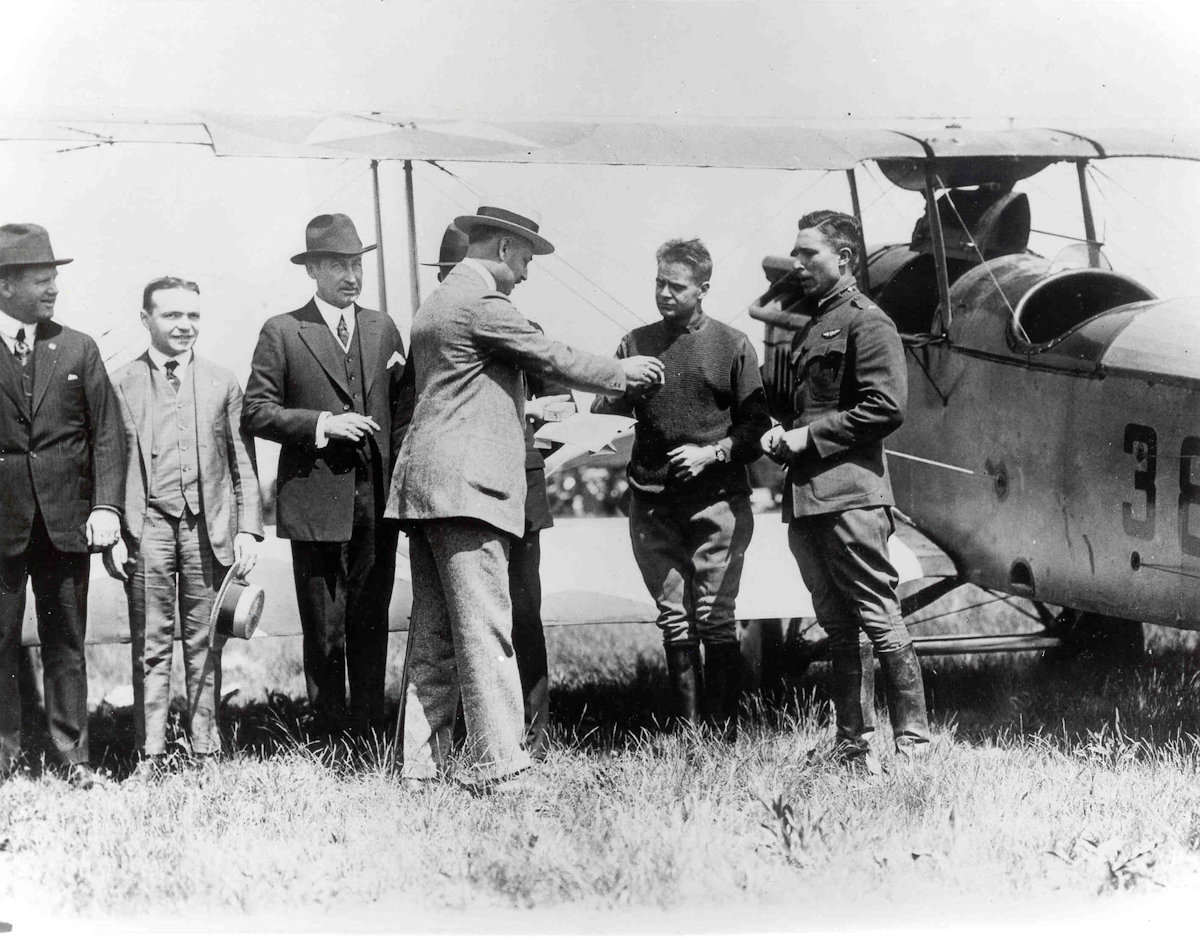
Airmail Planes at Reno, Nevada
Airmail employees transferring airmail bags from one de Havilland (DH-4B) aircraft to another at the Reno, Nevada airmail field. On September 8, 1920, the Post Office Department completed the western leg of the nation’s transcontinental flyway. Mail was flown through Reno on its way between San Francisco, California and New York City, New York.
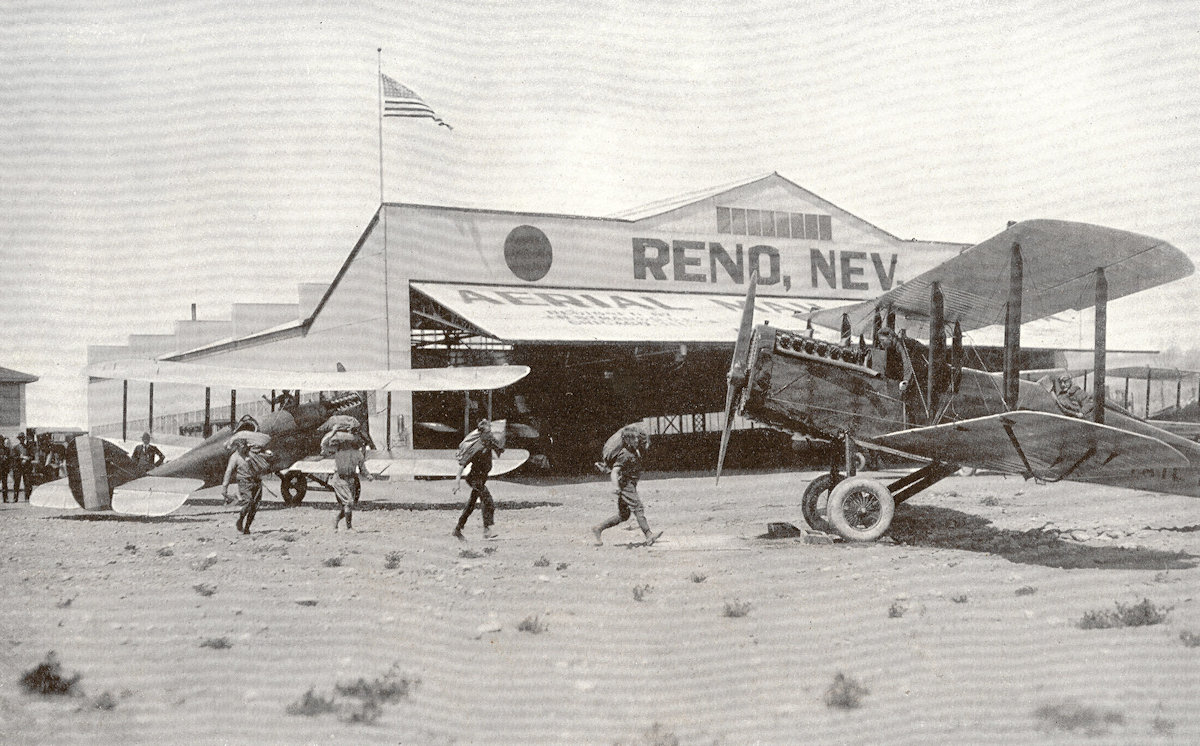
Airmail Planes at Omaha, Nebraska
The first airmail field used by the Post Office Department in Omaha, Nebraska was known as Ak-sar-Ben Field (or Nebraska, spelled backwards). The field was part of the transcontinental flyway between New York City, New York to San Francisco, California.

Airmail Pilots Edison Mouton and Rexford Levisee
Edison E. Mouton and Rexford Levisee pose in front of an airmail service biplane at Reno, Nevada. Mouton served as an airmail pilot from September 8, 1920 until May 22, 1927. Levisee served as an airmail pilot from November 9, 1920 to January 14, 1921, and from February 24, 1921 until June 30, 1927. Both pilots were assigned to San Francisco, California, Salt Lake City, Utah, and Reno, Nevada during their careers.
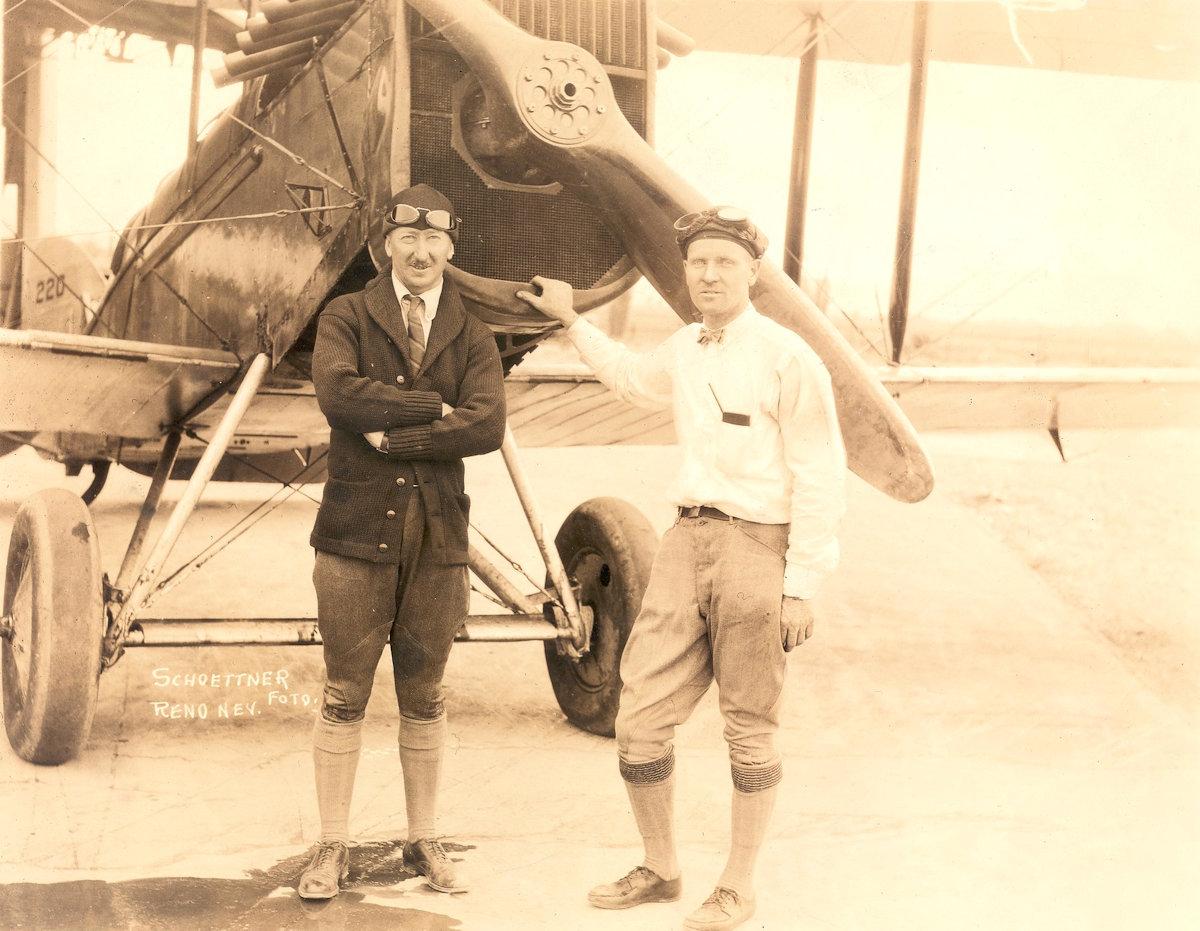
First bag of overnight Airmail gets delivered
Airmail pilot Paul S. Collins watches as employees remove a bag of mail from his airplane at Hadley Field, New Jersey on the evening of July 1, 1925. This mail was part of a series of flights carrying mail along the US transcontinental flyway by night. The Post Office Department had been flying mail across the country by day since September 8, 1920, but it was not until beacon lights were installed along the route that the airmail planes would fly on a regular schedule during both day and night.

Airmail pilot Jack Knight speaks into radio
Airmail pilot Jack Knight and an unidentified man stand next to Knight’s de Havilland airplane. In 1922, Knight was one of a group of airmail pilots who helped test the use of radios in aircraft for the Post Office Department. Aircraft at this time didn’t include radios, and there was much discussion as to whether they should. Here Knight is shown speaking into his aircraft’s radio as the other man looks on.
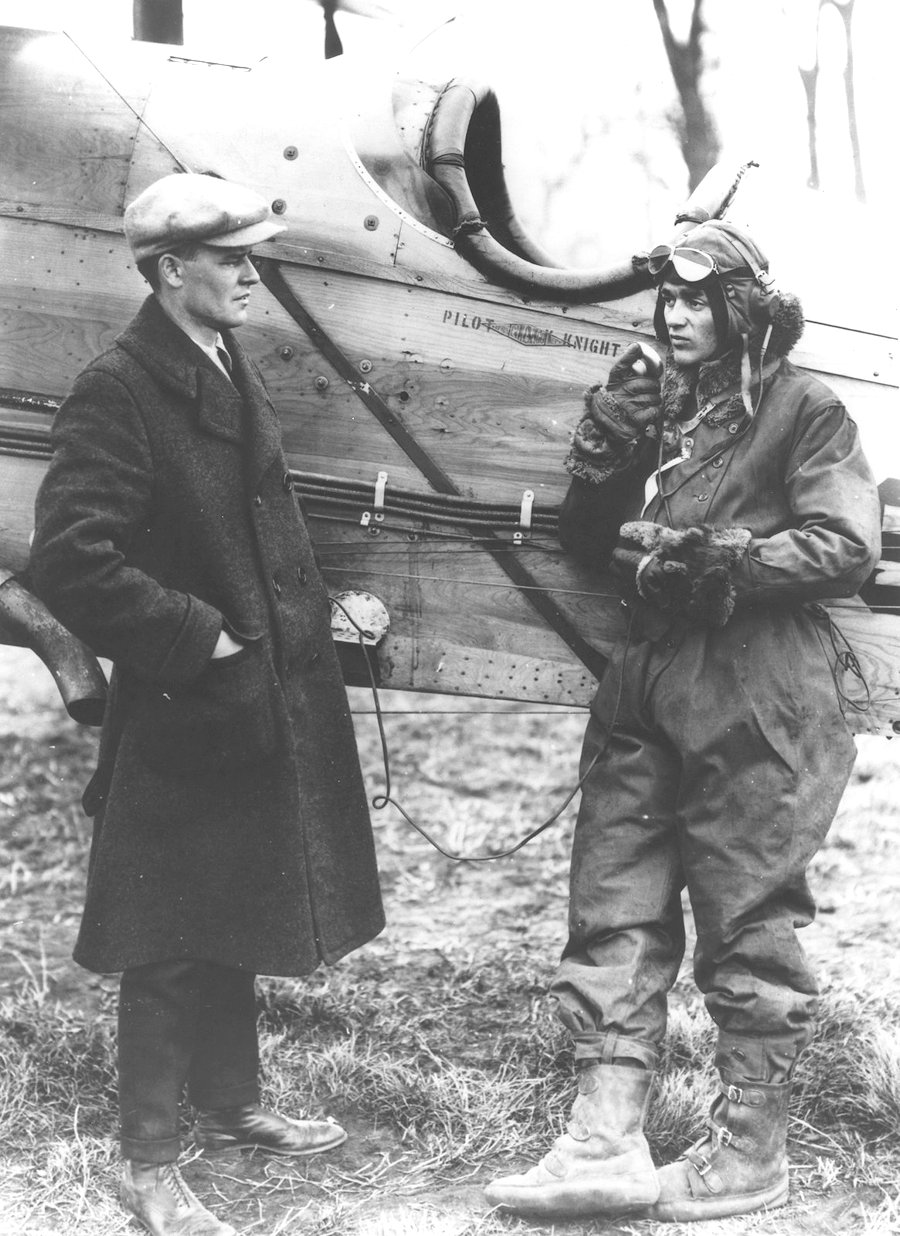
Airmail pilot James Hill gets ready for Transcontinental night flight
US Postmaster General Harry S. New poses with airmail pilot James D. Hill and an unidentified military officer for the start of regularly scheduled transcontinental night and day airmail flights. New is shown presenting Hill with a ceremonial bundle of mail that was added to the cargo. As Hill prepared to take off from Hadley Field, New Jersey, hundreds of cars lined the field with their headlines on, adding their lights to those of the field for his take off shortly before 9 pm.

JR-1B mail airplane designed by the Standard Aircraft Corporation
The JR-1B mail airplane, pictured here in 1918, was one of just six the Post Office Department purchased from the Standard Aircraft Corporation of Plainfield, New Jersey. The U.S. mailbag shown painted on the side of the airplane was painted by Airmail pilot Max Miller.
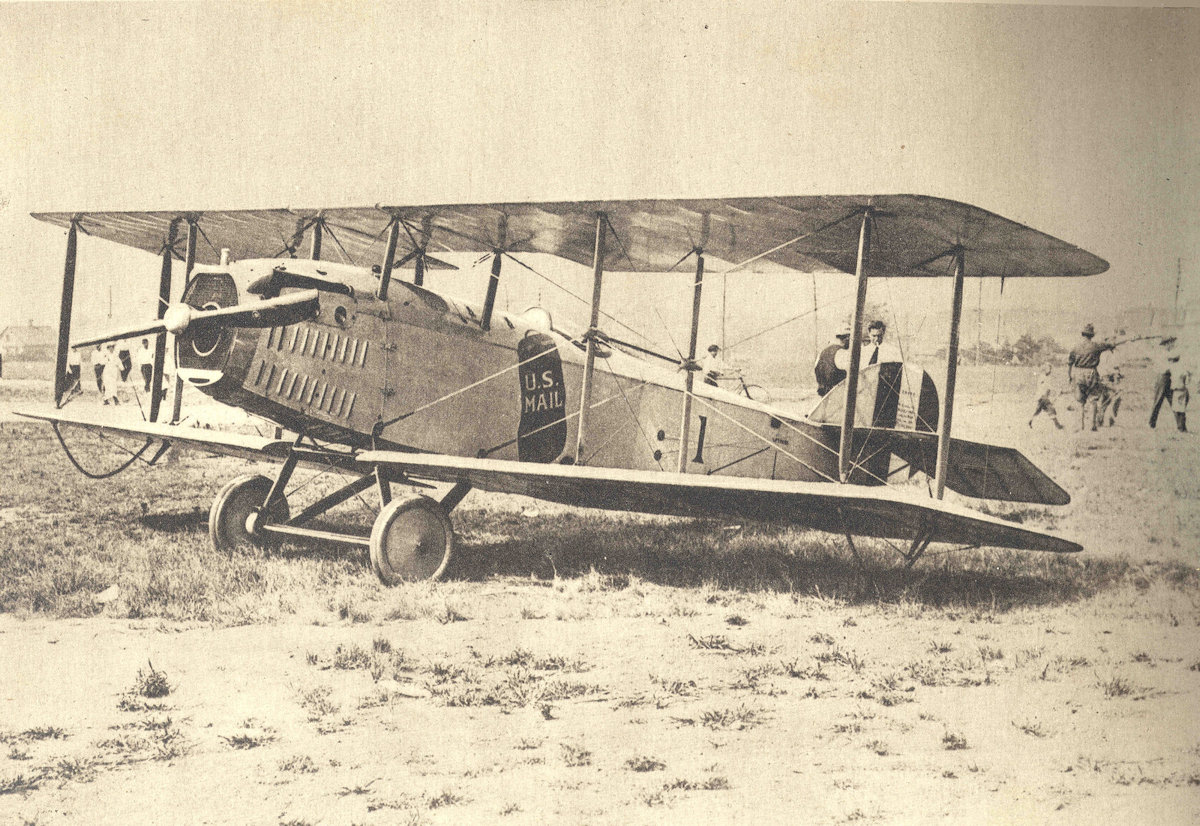
Airmail plane get unloaded at Chicago
Airmail employees at a Chicago airmail field are shown unloading mail from a recently arrived de Havilland mail airplane. A Post Office Department driver poses with the truck he will use to bring the mail to the Chicago post office. By the summer of 1924, airmail was being flown across the country in just over 30 hours, a dramatic improvement over the two to three days mail traveled by train.

New York City Postmaster with Airmail pilot in 1918
Postmaster Thomas G. Patten is shown handing Lt. Torrey Webb a bag of airmail letters for one of the first regularly scheduled airmail flights in the United States. On May 15, 1918, the United States officially established airmail service between New York, Philadelphia, and Washington, D.C., under the direction of the Post Office Department, using army aircraft and pilots. The army pilots chosen to fly that day were Lieutenants Howard Culver, Torrey Webb, Walter Miller and Stephen Bonsal. Lt. Torrey Webb carried the first day’s mail in this Curtiss Jenny aircraft from a temporary airmail field at Belmont Park, Long Island, New York to Bustleton Field, near Philadelphia, Pennsylvania.
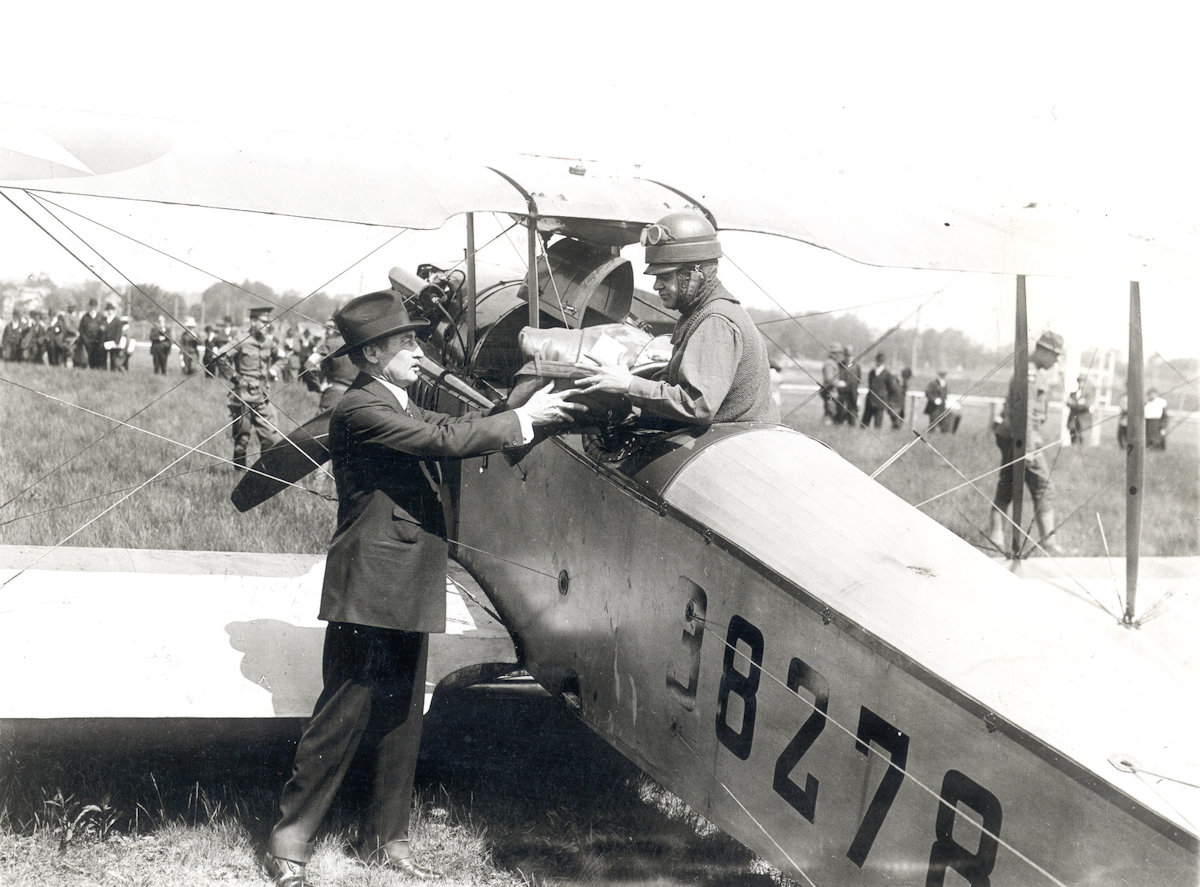
Airmail pilot Eddie Gardner with others
Airmail pilot Eddie Gardner sits on the engine of one of the Post Office Department’s Curtiss Jenny (JN-4H) mail airplanes. Among the men posed in front of the airplane are another airmail pilot, Robert Shank (far left), and airmail mechanic Eddie Radell (second from left). Photo taken in 1918.
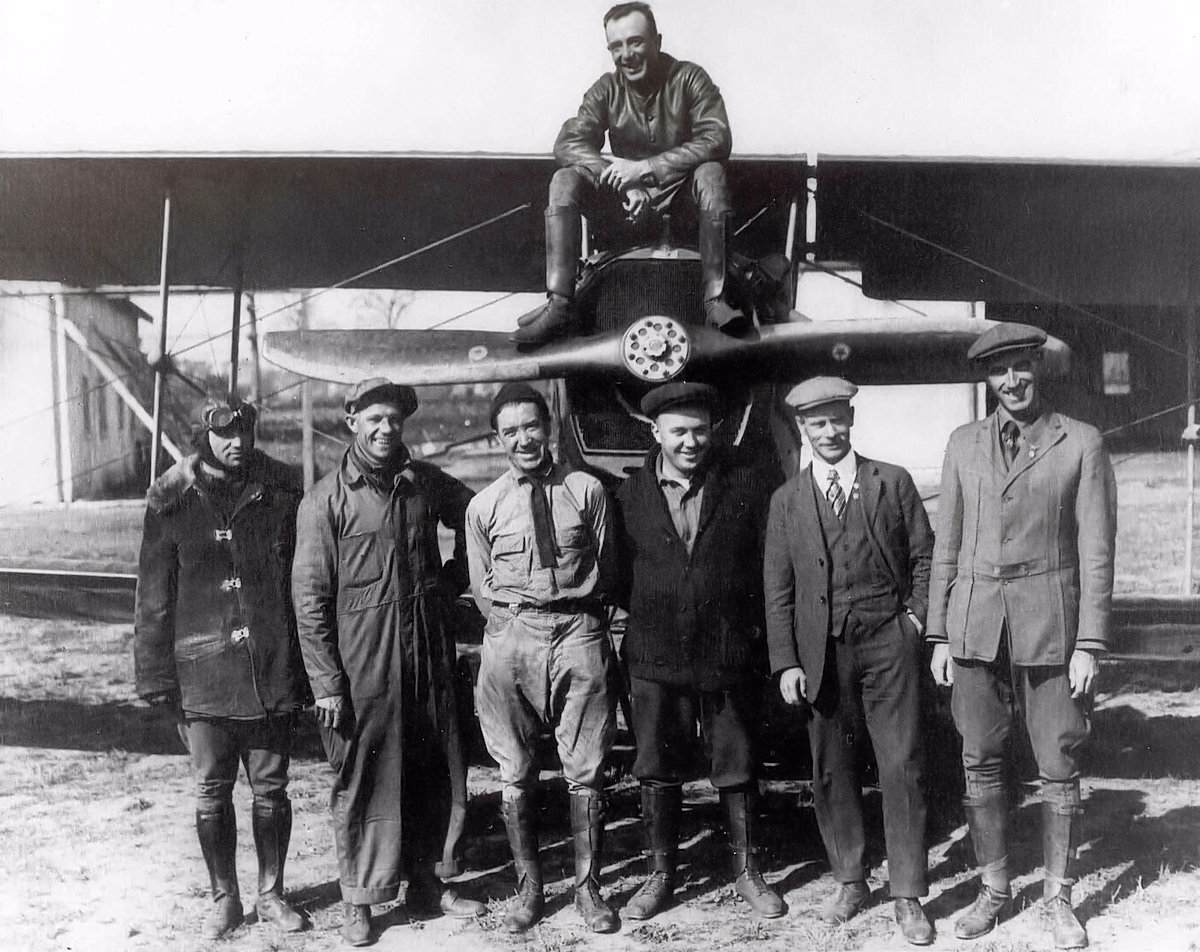
Army Air Corps pilots Major Reuben Fleet and Lt. George Boyle
Major Reuben Fleet of the Army Air Corps (left) and Lieutenant George Boyle (right) standing near a Curtiss Jenny (JN-4H) airplane on May 15, 1918. Major Fleet was tasked by the U.S. Army and the Post Office Department with arranging the first regularly schedule airmail service flights in the United States. The pair are admiring Major Fleet’s new wristwatch. The Hamilton Watch company presented each of the Army Air Corps airmail pilots with a new wristwatch in honor of their historic flights.
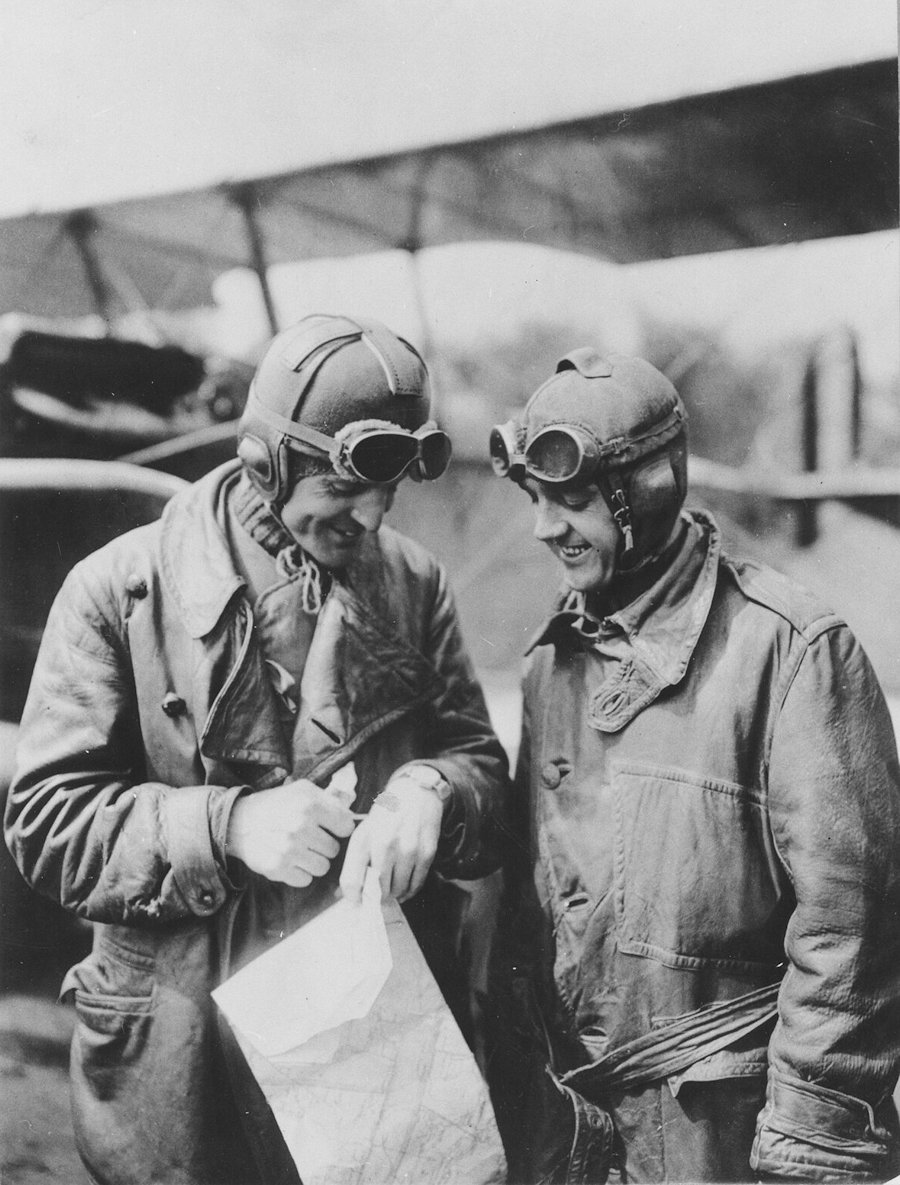
Modified de Havilland Airmail Plane #299
This version of the basic de Havilland airmail plane has been modified to hold 1000 pounds of mail (twice as much as a regular de Havilland mail plane). Postal officials nicknamed it the “pregnant cow.”
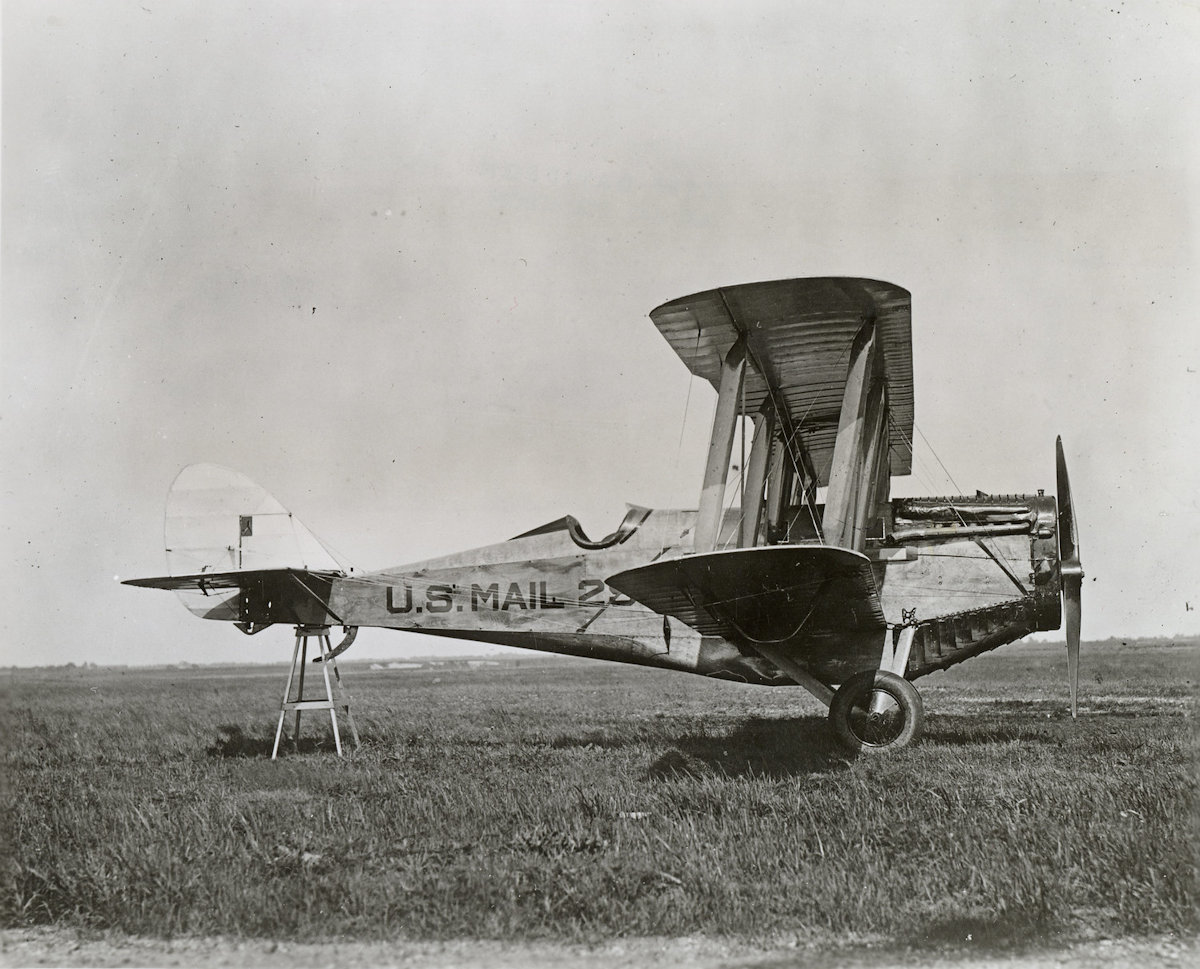
Mail Truck and de Havilland Airmail Plane
This photo from 1922 shows a de Havilland airmail plane parked on unidentified airfield next to a U.S. mail truck.

Pilot climbs up his wrecked Airmail plane
On June 6, 1918, Army pilot Lt. Webb was asked to fly a Curtiss R-4 aircraft to carry the mail from New York to Boston on a trial run to connect the two cities by air. When landing the plane at Franklin Park aviation field in Saugus, Massachusetts, the airplane hit a mudhole and flipped over. Nobody was injured, and the airplane as repaired and was back in the air just five days later.
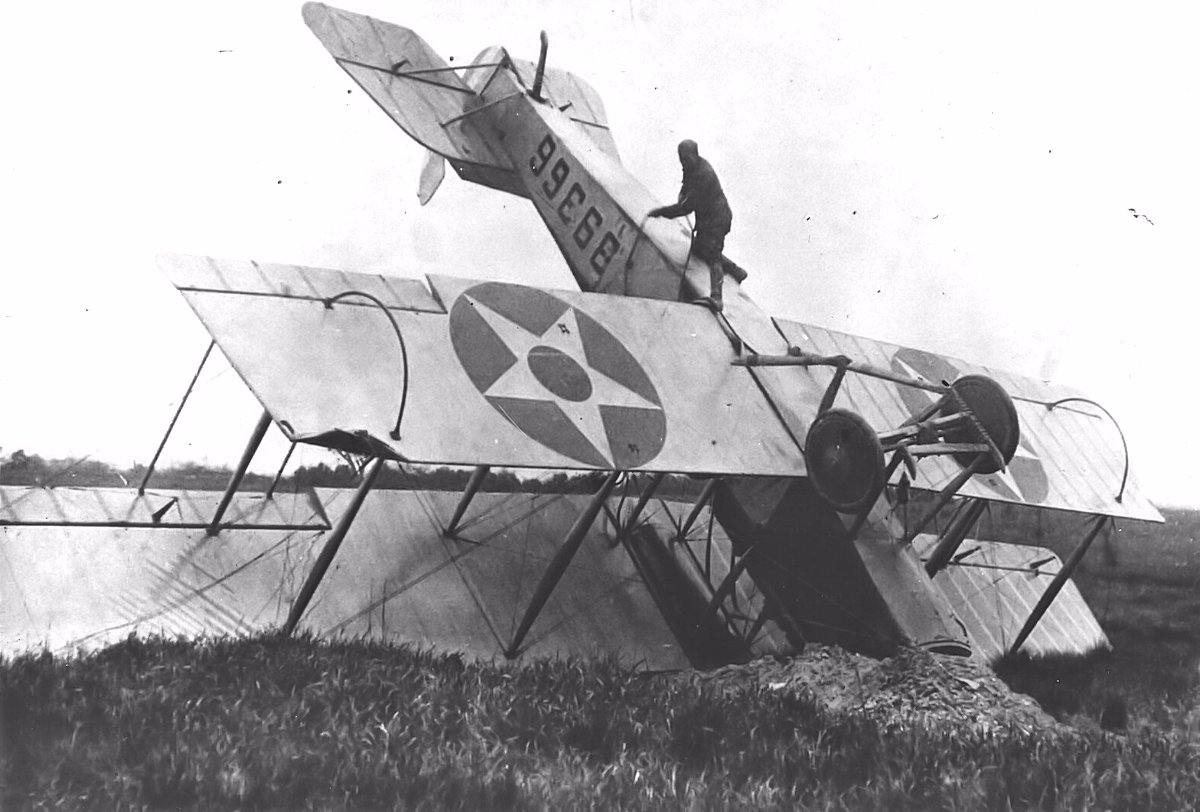
Airmail Pilot E. Hamilton Lee
Airmail pilot E. Hamilton Lee, shown here in 1924 posing in front of an airmail plane, served as an airmail pilot for the Post Office Department from 1918 to 1927. After his airmail service ended, he flew for United Airlines, retiring from the company in 1949. At that time he had flown longer and farther than any other pilot alive.
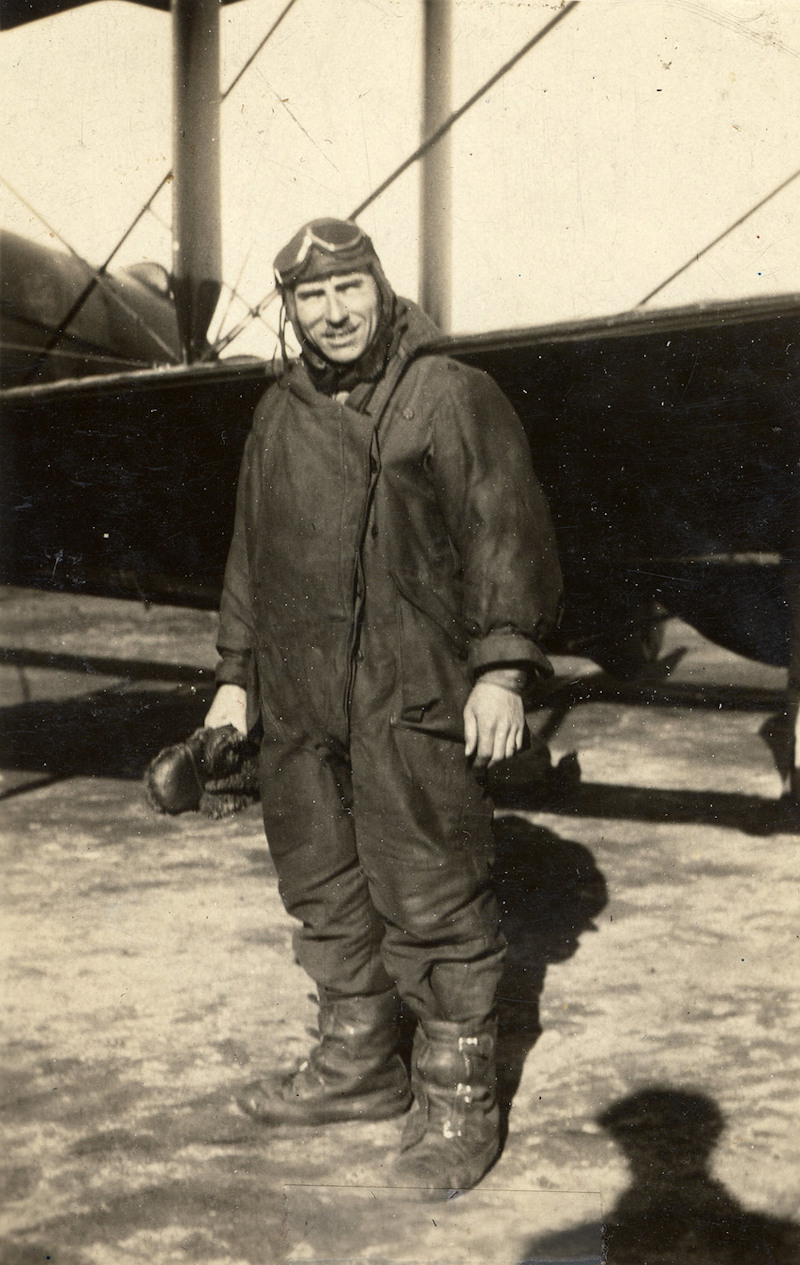
Omaha, Nebraska Airmail Field in 1927
Airmail planes shown in front of a hangar on the Omaha, Nebraska airmail field in 1927. This photo was taken a few years later than the Omaha Airfield photo shown above.
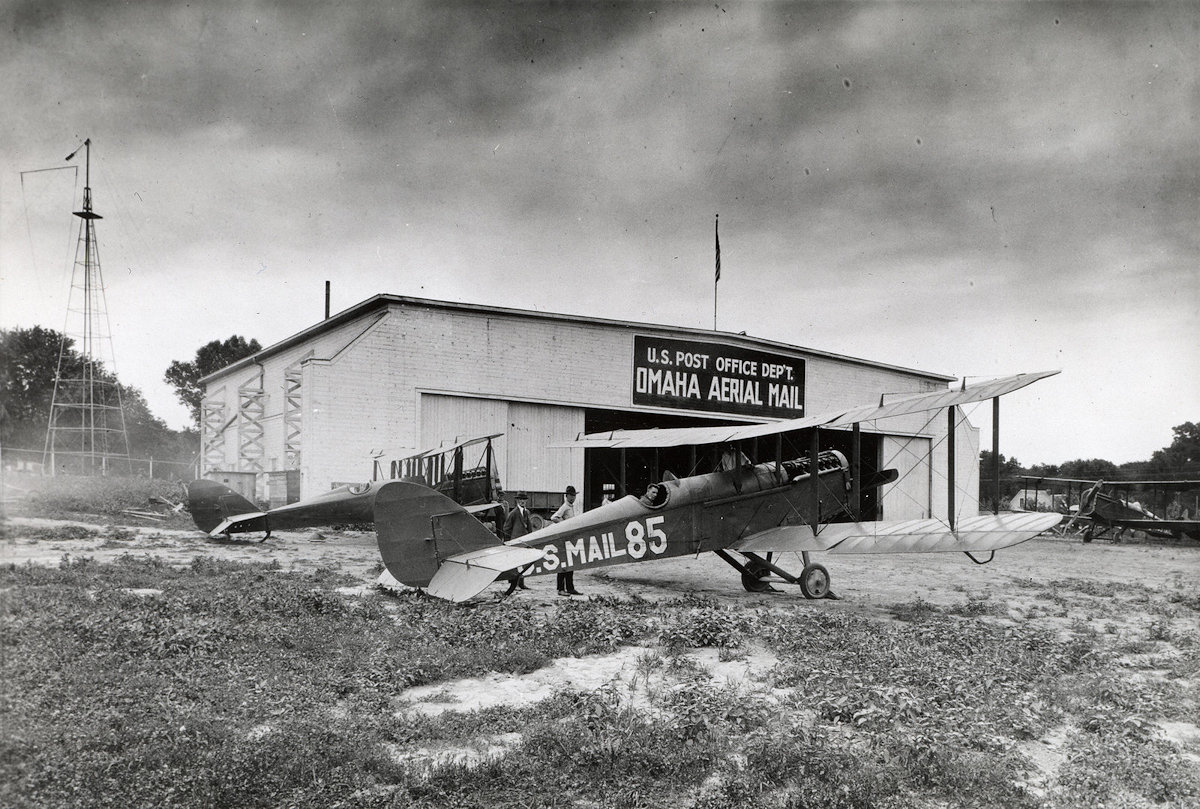
Airmail pilot Eddie Gardner posing with plane
Airmail pilot Eddie Gardner is shown with a JH-4H “Jenny” Post Office Department mail airplane. He is wearing leather leggings and a leather helmet that are now in the collections of the National Postal Museum. Gardner worked as an airmail pilot for the Department from August 1918 to April 1919.

Airmail pilot E. Hamilton Lee in the cockpit
E. Hamilton Lee hams it up in this photograph of himself in his de Havilland mail airplane. Lee flew off and on for the Post Office Department for most of its 1918-1927 run. After his airmail service ended, Lee flew for United Airlines, retiring from the company in 1949. At the time of his retirement, he had flown longer and farther than any other pilot alive.
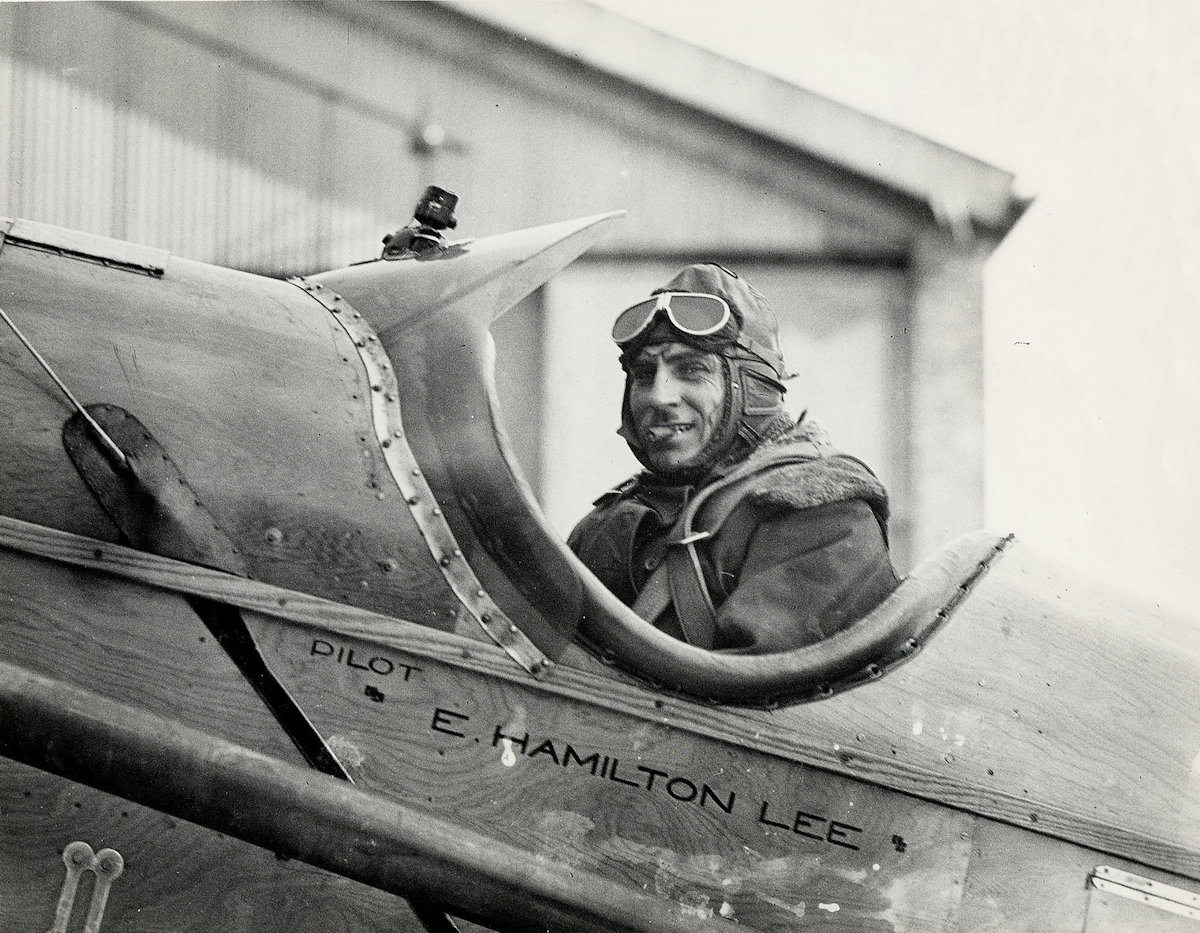
Airmail pilot John F. Milatzo
John Milatzo began his career with the Post Office Department’s Airmail Service on February 24, 1923. On April 22, 1927, while flying from Chicago to New York, he encountered a rough snow storm. Ice collected on his airplane, forcing him to try and land at night. His plane crashed in a field not far from Goshen, Indiana, and he was killed. He was the last pilot to die while working in the Post Office Department’s Airmail Service.
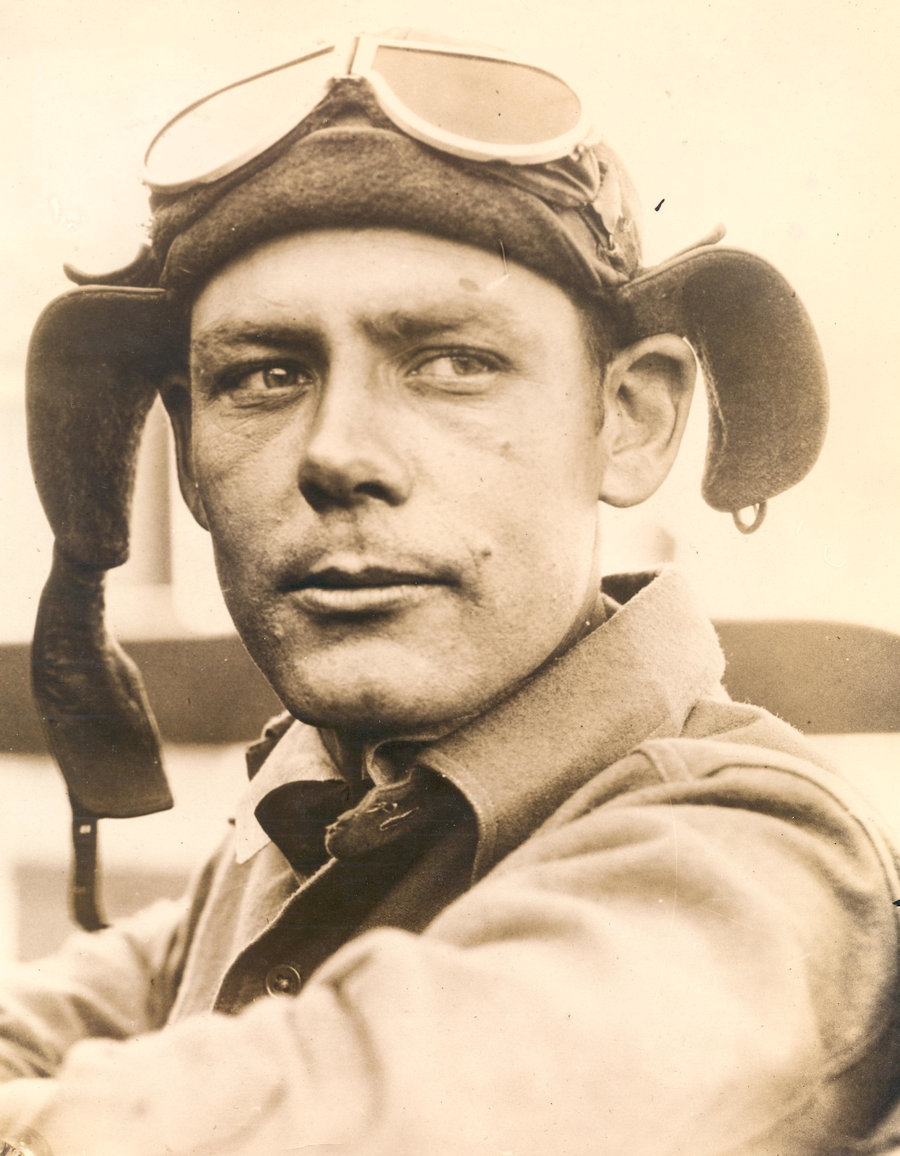
Standard Aircraft’s redesigned JR-1B mail airplane
In 1918, the Standard Aircraft Corporation modified the design of one of its military planes, which had two cockpits, by covering the front cockpit and converting it to a hold for mail. They also fitted them with 150-horsepower Hispano-Suiza engines and longer top wings. The Post Office Department purchased six of these converted aircraft for use as mail airplanes.

Western Air Express Fokker F-10 Airmail plane
A Fokker F-10 super tri-motor airplane marked with the name “Fokker F-Ten” on the tarmac at the Oakland, California, airport. This airplane was one of five used by Western Air Express to carry both mail and passengers on its Los Angeles San Francisco route in the late 1920s.

Loading airmail in New Brunswick, New Jersey
Postal employees loading mail into a de Havilland mail airplane at Hadley Field in New Brunswick, New Jersey. Regularly scheduled transcontinental airmail service, which had begun in the summer of 1924, was extended to east coast with the completion of a series of airmail beacons that helped guide pilots across the country.
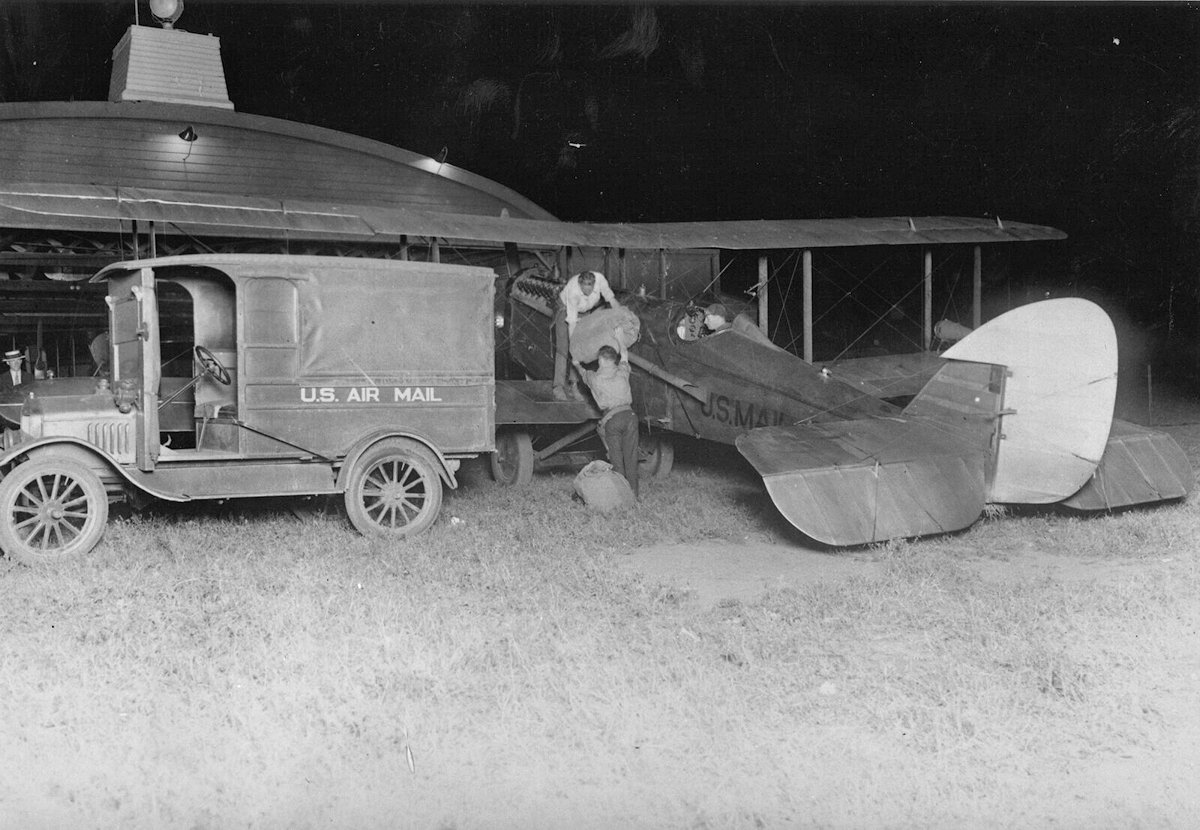
Unloading Airmail in Omaha, Nebraska on July 1, 1924
Postal workers in Omaha unload a de Havilland (DH-4B) airplane that had been flown by airmail pilot Frank Yager, who had left North Platte, Nebraska, for Omaha at 11:20 p.m. When he arrived in Omaha, over 3,000 people had crowded the airfield to welcome him. It was the first regularly scheduled nighttime transcontinental airmail flight.

Airmail pilot Ira Biffle poses in winter flight gear
Shown here leaning on his plane in Chicago, Ira Biffle served as an airmail pilot for the Post Office Department from 1918-1919 and 1923-1927. In 1922, while serving as a flying instructor in Lincoln, Nebraska, Biffle taught flying to a young Charles Lindbergh.
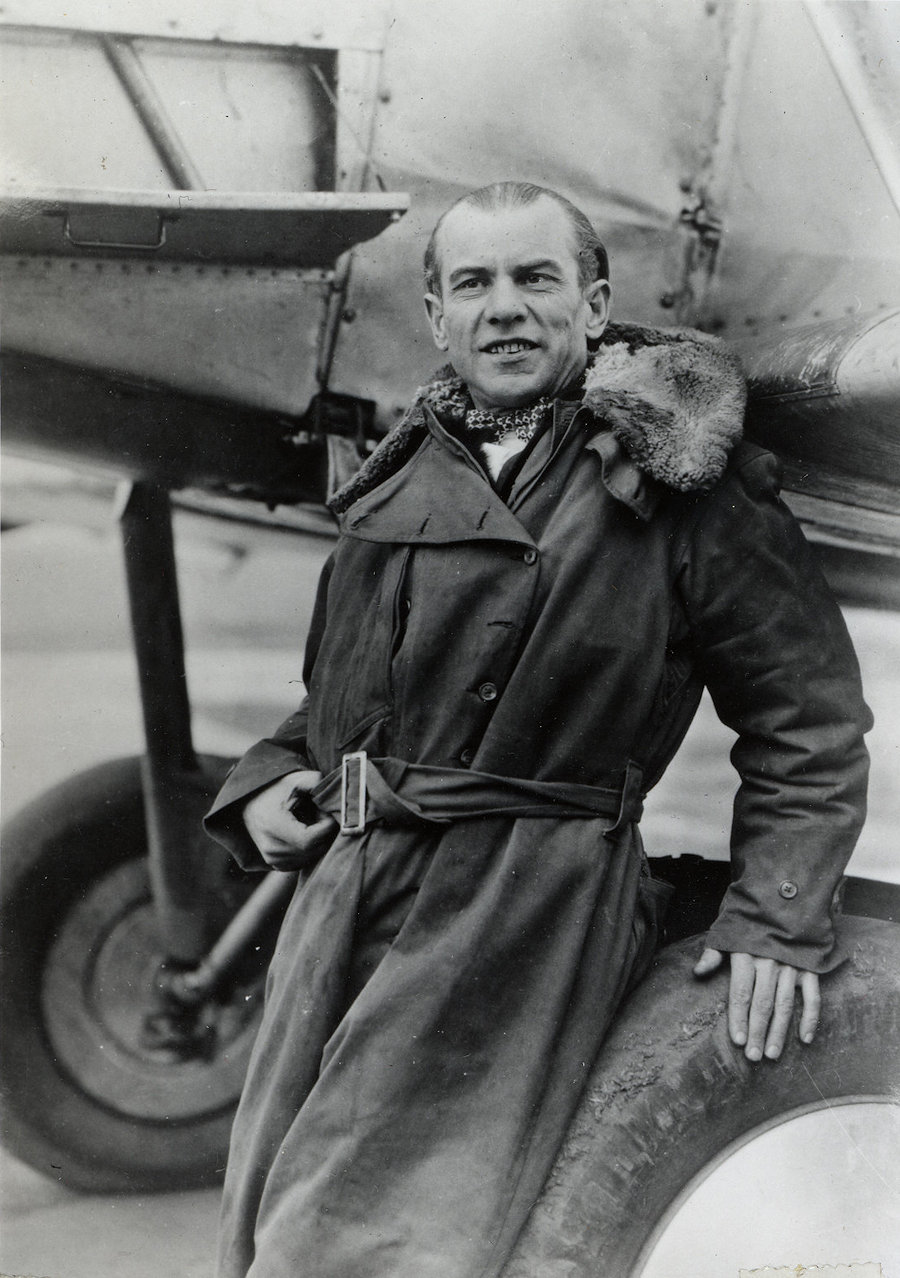
Loading an Airmail plane at Reno, Nevada
Airmail employees transferring airmail bags from one de Havilland (DH-4B) aircraft to another at the Reno, Nevada airmail field. On September 8, 1920, the Post Office Department completed the western leg of the nation’s transcontinental flyway. Mail was flown through Reno on its way between San Francisco, California and New York City, New York.
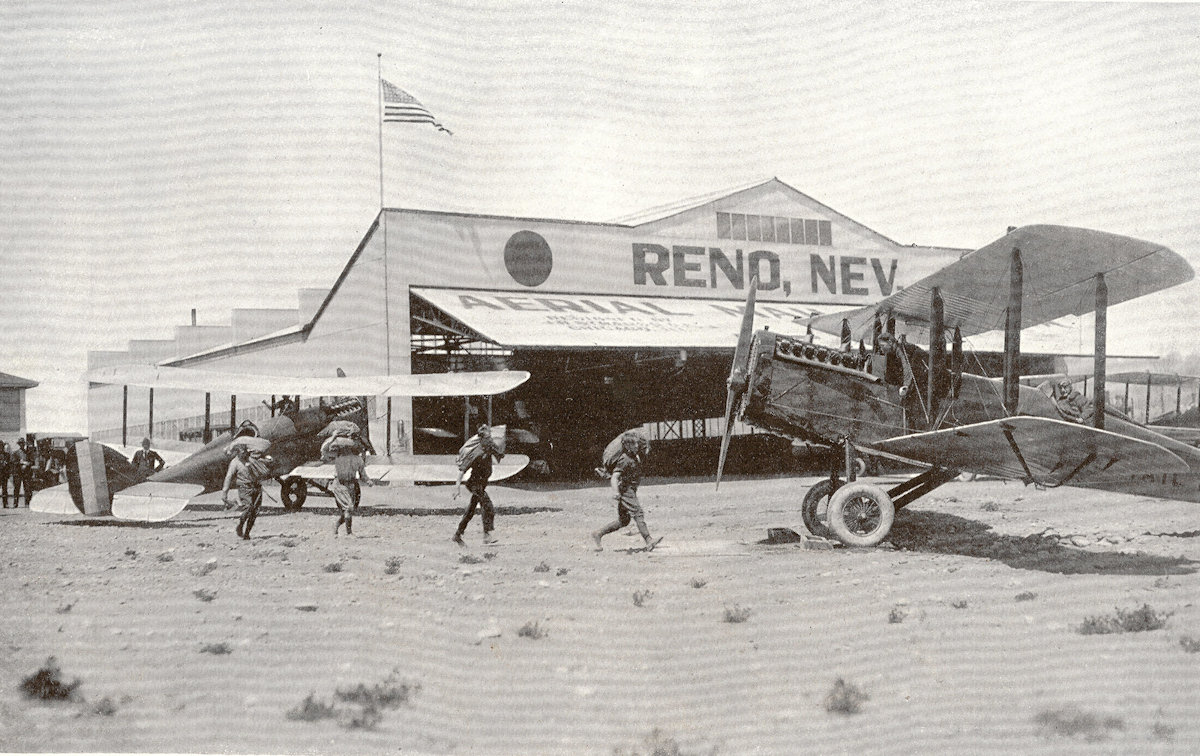
Airmail Pilot Max Miller and Benjamin Lipsner
This is an image of Benjamin Lipsner (holding mailbag), Superintendent of the Airmail Service, and airmail pilot Max Miller (wearing flight gear). Miller is about to begin his pathfinding flight between New York and Chicago.
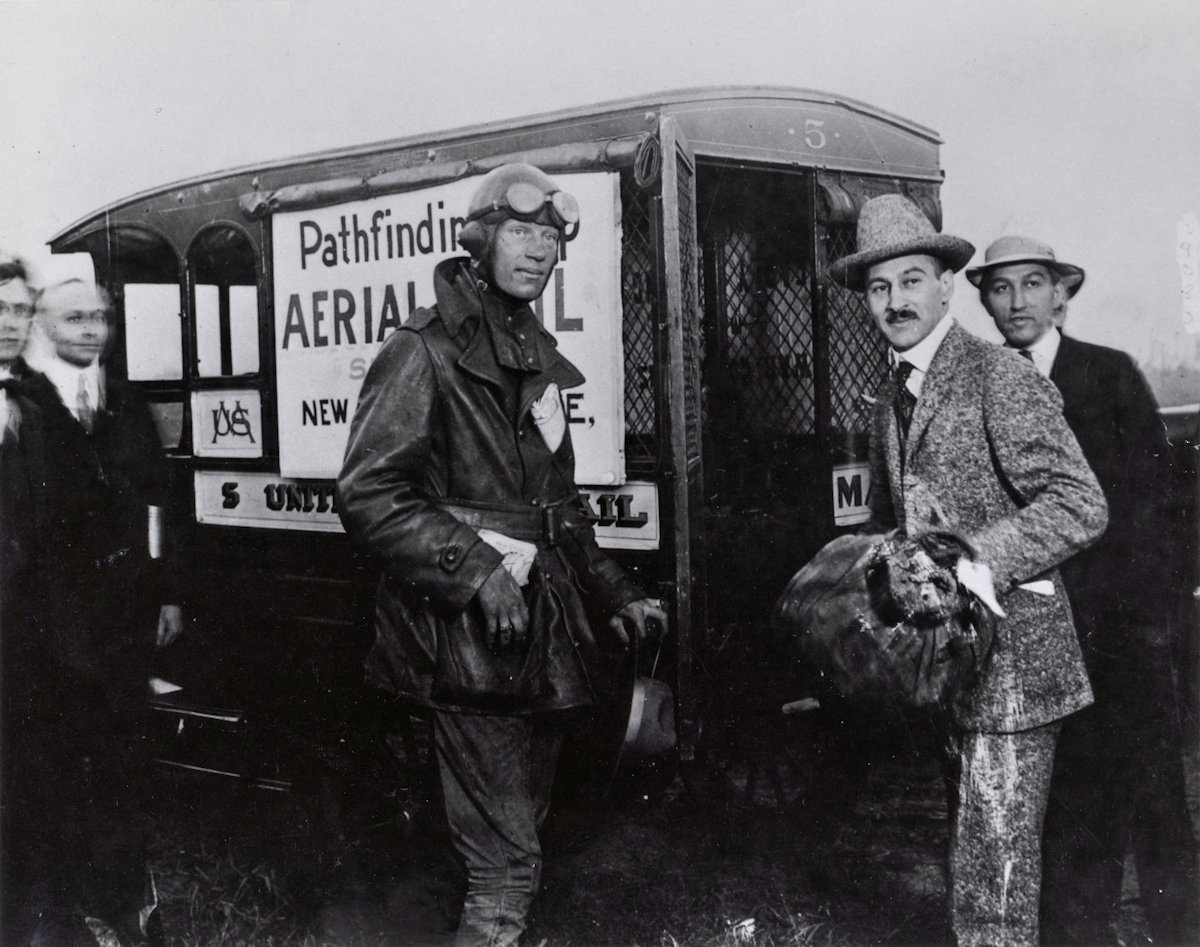
Photograph of Airmail pilot Wesley Smith
Wesley Smith was a pilot for the Post Office Department’s airmail service from November 8, 1919 to June 15, 1927, making him one of the longest serving pilots in the Department. He spent most of his time in the service based in the New York and New Jersey airmail fields. During one of his earliest flights, he encountered heavy fog and used his compass to navigate over it. When he came down to see where he was, he flew into trees on the Orange Mountains. He survived the crash and continued to fly with the Airmail service, then eventually went on to serve as the operations manager for National Aviation Transport (NAT).
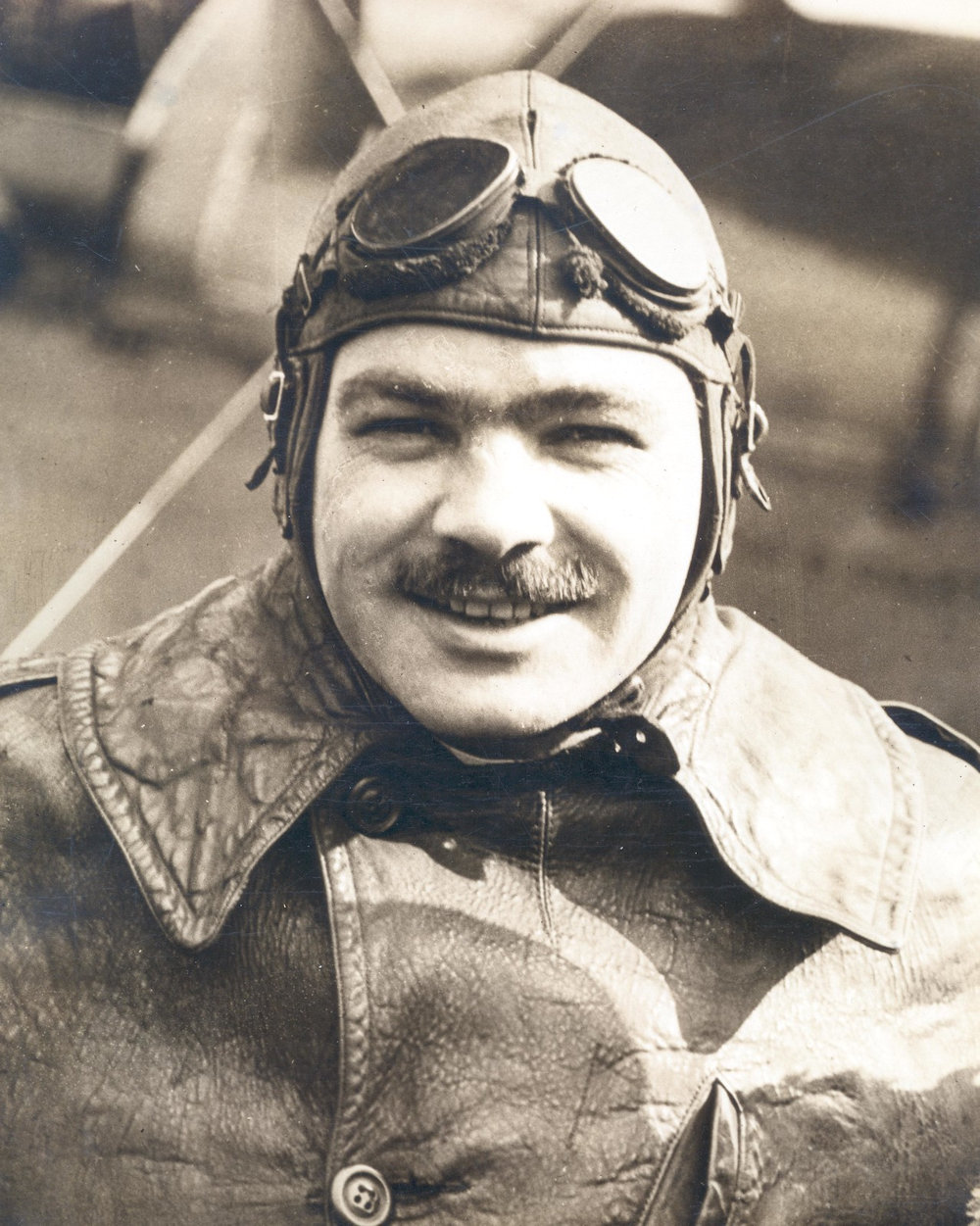
Photograph of Airmail pilot Shirley J. Short
Pictured here in his de Havilland DH-4B airmail plane, Shirley J. Short flew as a postal airmail pilot from March 2, 1923 until August 31, 1927. During much of that time he flew the mail between Chicago, Illinois and Cleveland, Ohio, and was a solid and reliable airmail pilot. In recognition of his service, he was selected as the recipient of the 1926 Harmon Trophy for the United States, an award given by the Ligue Internationale des Aviators.
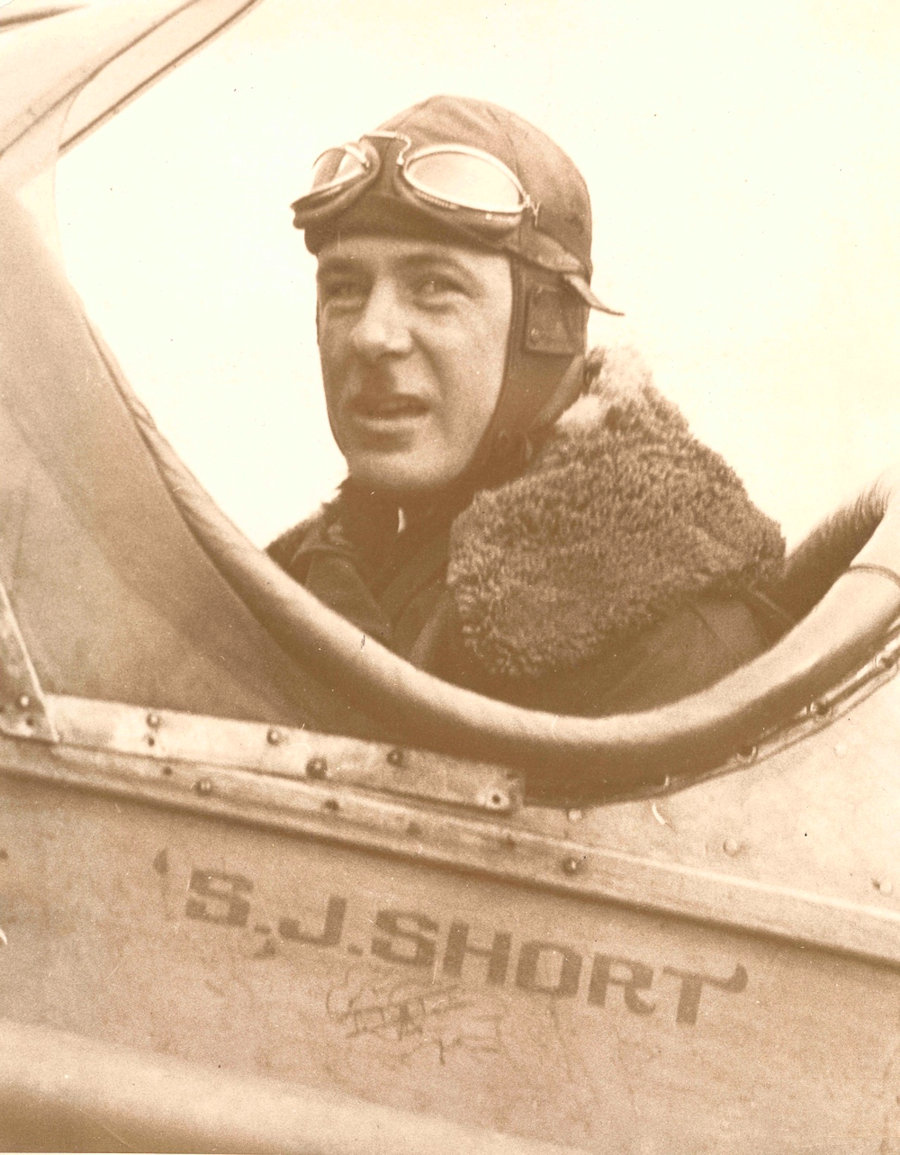
Photograph of Airmail pilot William Carroll
William Carroll began flying for the Post Office Department on August 7, 1920. On October 16, 1920, he was transferred to a newly created airmail line connecting Chicago and Minneapolis. He was piloting a Junkers JL-6 aircraft with fellow airmail pilot Hiram H. Rowe and mechanic Robert B. Hill on board. Carroll was taking the pair on a path-finding tour of the route on February 9, 1921 when tragedy struck. Witnesses reported hearing an explosion and watching in horror as the airplane burst into flames and dived into the ground. All three men were killed in the crash.
